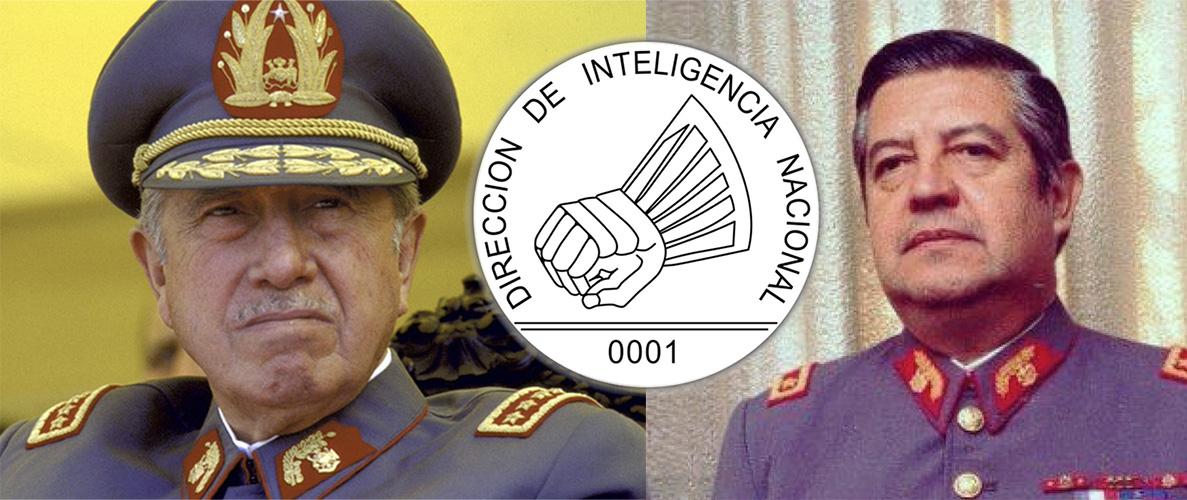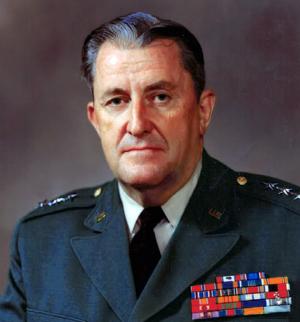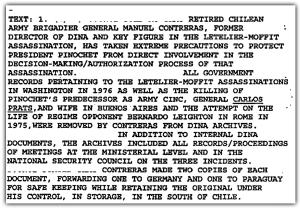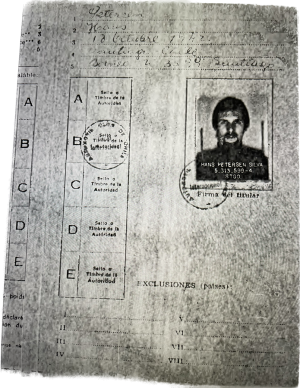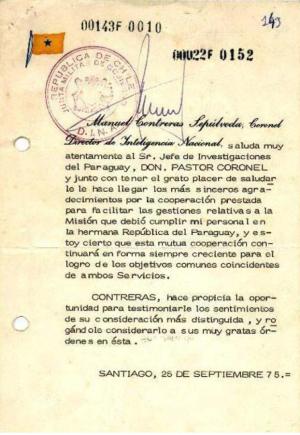The Pinochet Regime Declassified
Washington, D.C., June 18, 2024 - On June 18, 1974, the official registry of the Chilean military dictatorship published Decree 521 on the “creation of the Dirección de Inteligencia Nacional (DINA),” the secret police force responsible for some of the regime’s most emblematic human rights crimes. To mark the 50th anniversary of DINA’s official creation, the National Security Archive today is publishing a curated collection of declassified CIA, DIA, FBI and State Department documents, along with key Chilean records, that reflect the history of DINA’s horrific human rights atrocities and terrorist crimes.
The decree signed by General Augusto Pinochet and other members of the military junta officially established DINA for “the purpose of producing intelligence collection requirements for the formulation of policies, plans and adoption of measures required for the security and development of the country,” but the measure also included three secret articles empowering DINA to operate as a secret police force to surveil, arrest, imprison and eliminate anyone considered an opponent of the regime. The new decree gave “legal/official blessing to an organization that is already fully active,” the U.S. Defense attaché reported to Washington. Other members of the Chilean military viewed the junta’s order as “the foundation upon which a Gestapo-type police force will be built.”
DINA was created as a military organization outside the military chain of command, instead reporting directly to Pinochet as chief of the junta.
As the principal agency of the regime’s apparatus of repression, DINA became infamous for its secret torture centers, extrajudicial executions, the forced disappearances of hundreds of civilians and acts of international terrorism. The sinister secret police force, according to a special TOP SECRET/SENSITIVE Senate report based on still classified CIA documents, eventually grew to 3,800 officers, operatives and administrative personnel—the figure is mistyped in the report as 38,000—with an annual budget of $27 million. According to that study, DINA “was established as an arm of the presidency, under the direct control of President Pinochet.” DINA’s director, Col. Manuel Contreras, according to the U.S. Defense Intelligence Agency, “has reported exclusively to, and received orders only from President Pinochet.”
As it expanded its operations, DINA also received organizational support from the CIA. In February 1974, Pinochet personally asked CIA deputy director Vernon Walters to assist DINA in its “formative period.” Walters hosted a luncheon for Contreras at CIA headquarters in Langley, Virginia in early March 1974. In mid-1975, the CIA briefly put the DINA director on its payroll as a paid asset.
The CIA Deputy Director, Lt. General Vernon Walters, provided CIA support for the formation of DINA.
The documents published here today record some of DINA’s most notorious operations:
** SECRET DETENTION AND TORTURE CENTERS: Although numerous units of the Chilean military routinely engaged in human rights abuses, during the first three years of the dictatorship, DINA was responsible for the majority of secret arrests, cases of torture and disappearances committed by the regime. One early U.S. intelligence report noted that DINA interrogation techniques of detained prisoners were “straight out of the Spanish Inquisition” and that DINA was “developing into a KGB-type organization as originally predicted.” One of DINA’s most sadistic torturers, Capt. Ricardo Lawrence, later provided a statement to the Chilean courts on the network of secret detention centers where these abuses took place—Villa Grimaldi, Londres No. 38, Venecia, Malloco, Jose Domingo Canas and Cuatro Alamos, among others—as well as the DINA units and commanders stationed there. Many of the torture victims in these secret detention centers were executed and then disappeared; many of them were dropped from DINA helicopters into the ocean.
Defense Department intelligence report titled "Contreras Tentacles" on his effort to hide and preserve DINA documents recording Pinochet's role in DINA's acts of international terrorism.
** OPERATION COLOMBO: Confronted with growing pressure from the families of the disappeared and international condemnation of these human rights atrocities, in 1975 DINA mounted a major disinformation campaign to provide what the U.S. Embassy called “some means of accounting for [the] disappearance” of Chileans. Code-named “Operation Colombo,” DINA agents planted false stories in obscure newsletters and newspapers in Brazil and Argentina claiming that Chilean leftists were killing each other in internecine political warfare. In Buenos Aires, agents deposited a dead body—its head and hands cut off—with identification papers of one of the disappeared Chileans and a note that read: “Brought down by the MIR,” one of the militant Chilean organizations. The false articles were then used by allies of the regime in the Chilean media to write false stories with headlines such as “Exterminated Like Rats” to advance the cover-up of the true fate of the disappeared. Investigative reporters, led by U.S. journalist John Dinges, quickly exposed Operation Colombo; the U.S. Embassy reported to Washington that the stories appearing in the Pinochet-controlled press in Chile were “probably untrue” and that the disappeared victims had actually been killed by Chilean security forces.
** PROJECT ANDREA: DINA was responsible for an ultra-secret program by the Chilean military to develop a chemical weapons capability to be used in case of war with Peru or Argentina and as a tool of clandestine assassination missions against enemies of the regime. DINA officials constructed a clandestine laboratory at the safe house of one of their leading agents, Michael Townley, who purchased equipment and chemicals in the United States. In addition to manufacturing Sarin nerve gas in the laboratory in Townley’s basement, DINA planned to produce even more dangerous chemical warfare gases known as “soman” and “tabun” using extremely toxic nerve agents such as Clostridium botulinum, saxitoxin and tetrodotoxin. According to a handwritten history of his DINA activities, Townley reported that nerve gas was used to murder at least two individuals in Santiago. As DINA’s leading international assassin, Townley considered using the sarin gas to assassinate Orlando Letelier in Washington, D.C., sending the deadly nerve gas to the U.S. hidden in a Chanel No. 5 perfume dispenser.
False travel documents with the alias "Hans Petersen" used by DINA hitman Michael Townley for the mission to kill Orlando Letelier in Washington D.C.
** OPERATION CONDOR: DINA was the organizer and leading member of Operation Condor, the multilateral collaboration between Southern Cone secret police services to track, seize and eliminate opponents of their regimes around the world. In October 1975, DINA director Manuel Contreras sent invitations to his secret police counterparts in Argentina, Bolivia, Uruguay, and Paraguay, inviting them to the “first working meeting on National Intelligence” scheduled in Santiago between November 25 and December 1, 1975. During that meeting, the delegates voted to honor their hosts by naming their new consortium for Chile’s national bird, the “Condor.” At the second Condor meeting, in Santiago in June 1976, the member countries created a collaborative death squad program—code named “Teseo,” for the avenging Greek demigod, Theseus—“to conduct physical attacks against subversive targets” abroad, according to CIA reports. Plan Teseo included a chilling section titled “Execution of the Target,” which stated: “This is the responsibility of the operational team which will (A) intercept the target, (B) Carry out the Operation, and (C) Escape.”
DINA Director Contreras' letter of appreciation to the Paraguayan secret police chief
for collaborating in the kidnapping and disappearing of a Chilean member of the Movimiento de Izquierda Revolucionaria (MIR).
** INTERNATIONAL TERRORISM: For decades, the Washington, D.C., car-bomb assassination of former Chilean Ambassador Orlando Letelier and his young colleague Ronni Karpen Moffitt on September 21, 1976, was believed to be Condor’s most infamous operation. In fact, the targeting of Letelier, a former Ambassador to Washington and Defense Minister in Salvador Allende’s government, was a mostly unilateral DINA mission, although it drew on Paraguayan support, under the Condor accord, to provide false travel documents for the assassination team. “The explicit orders,” according to Michael Townley, DINA’s leading hitman, “were: Find Letelier’s home and workplace and contact the Cuban group [of violent exiles working with DINA] to eliminate him, or use SARIN gas, or orchestrate an accident, or in the end by whatever method—but the government of Chile wanted Letelier dead.” The Letelier assassination was the third high-profile act of international terrorism committed by DINA operatives: in September 1975, former Christian Democrat Party vice president Bernardo Leighton and his wife were gunned down on the streets of Rome; both survived with crippling injuries. In September 1974, retired Chilean General Carlos Prats and his wife Sofia were killed by a car bomb—also planted by Michael Townley—in Buenos Aires.
As an act of international terrorism in the capital city of the United States, the Letelier-Moffitt assassination brought renewed international pressure and criticism from inside the Chilean military on General Pinochet to curb DINA’s operations. Eleven months after the car bombing, as the FBI focused on DINA’s role, the Pinochet regime announced that DINA would be dissolved. Decree 521 would be rescinded, and a new decree established the “Center for National Intelligence” (CNI). U.S. intelligence reports and Embassy assessments noted that the rebranding of the Chilean secret police was largely cosmetic. Numerous DINA agents were simply transferred to the CNI, which, like DINA, reported only to General Pinochet. Disappearances diminished, but CNI agents continued to commit human rights atrocities between 1977 and 1990 when Pinochet was forced to yield power to civilian rule.
In January 1978, the U.S. Justice Department indicted Manuel Contreras and his DINA deputy Pedro Espinosa for their roles in the Letelier-Moffitt assassination and demanded their extradition. Pinochet protected them from prosecution, blackmailed by Contreras who made it clear that he had hidden documents that would reveal that Pinochet himself ordered the terrorist operation. After the return to democracy in Chile, they were both prosecuted and convicted, becoming the first Chilean military officers to be held accountable for human rights crimes, and a special luxury prison was constructed to house them. Both were later convicted of other human rights crimes. Contreras died in prison in 2015. Pinochet, who was indicted but never convicted for human rights crimes, died on December 10, 2006—International Human Rights Day.
“DINA's unique structure and lethally effective methods of operation were critical to the alliance of right-wing civilian and military forces that destroyed Chile’s democracy. The history of DINA gains fresh relevance in light of the emerging authoritarian and anti-democratic political movements in the world, including in the United States,” observed John Dinges, author of The Condor Years and the forthcoming book Chile in Our Hearts: The Untold Story of Two Americans who Went Missing After the Coup.
Peter Kornbluh, who directs the Archive’s Chile Documentation Project, said: “Fifty years later, these documents remind us of a history of repression and crimes against humanity that, now more than ever, must not be forgotten.”
The Documents

Document 1
Rettig Truth Commission Papers
On June 14, 1974, General Pinochet and the other members of the Chilean military junta signed Decree 521, officially establishing the secret police and intelligence service known as DINA. In fact, DINA had been secretly created by Pinochet in mid-November 1973 and was already fully operational; Decree 521, published in the “Diario Oficial” of the government four days later, legalized its operations. Beyond its intelligence-gathering mission, articles 9,10 and 11 empowered the DINA to use secret police functions of detention and interrogation. When the decree was published in the government registry, those three articles were kept secret. This original copy was obtained by journalist Jorge Escalante as part of his work with the Archivos Chile project “Secret Decrees” and published in 2010. The existence of the secret provisions was revealed in 1975 by Jose “Pepe” Zalaquett, an attorney on the staff of the Committee for Peace human rights organization, in off the record conversations with journalists, including John Dinges.

Document 2
Clinton Chile Declassification Project
The U.S. Defense attaché in Santiago transmits a translation of the censored version of Decree 521 establishing the DINA, as published in the Diario Oficial of the government on June 18, 1974. His report notes that the decree provides “legal/official blessing” for an intelligence service that is “already fully active” and that other members of the Chilean military consider the decree to be “the foundation upon which a Gestapo-type police force will be built.”

Document 3
Clinton Chile Declassification Project
In one of the earliest U.S. reports on DINA, sent only eleven weeks after it was secretly created, the U.S. air force attaché provides information on the directorate’s ability to intimidate and control the judicial system as well as government ministries in Chile. “If DINA has spread out to the point where it can take a case out of the normal legal channels without recourse by the courts or other executive agencies, it has become a power to be watched,” he warns. “There are three sources of power in Chile,” a high-level Chilean military source informs the U.S. officer: ‘Pinochet, God and DINA.”

Document 4
Clinton Chile Declassification Project
Less than three months after DINA’s secret creation, the U.S. military attaché reports on its use of torture on detained prisoners. According to a Chilean officer in CECIFA, a counterintelligence unit of the Chilean military, DINA is using interrogation techniques “straight out of the Spanish Inquisition and often leave the person interrogated with visible bodily damage.” Other members of the Chilean military, according to this secret cable, view DINA as “the monster, reflecting their apprehension about its growing power and size.”
![CIA, Cable, “Personal to Dr. Henry A. Kissinger [from CIA Deputy Director Vernon Walters on Secret Meeting with Pinochet],” Secret, February 14, 1974](/sites/default/files/styles/thumbnail/public/2024-06/DINA-5-Walters-and-Pinochet-1%20copy.jpg?itok=9nJ8nLYm)
Document 5
Library of Congress, Kissinger Papers
In mid-February 1974, CIA Deputy Director Vernon Walters secretly traveled to Santiago to meet face to face with General Pinochet. “I conveyed greetings from the President and Secretary [Kissinger],” Walters reported back to Kissinger in this telegram, “as well as our friendship and support … and our wish to be helpful in a discreet way.” Pinochet accepted this offer and asked the CIA to support his new secret police service, DINA, and “his key man,” Col. Manuel Contreras, who would be DINA’s director. “I told him we would be glad to have Contreras or anyone else come up to see us to see what we could do to be of assistance to them,” Walters informed Kissinger. Three weeks later, Walters hosted Col. Contreras at CIA headquarters in Langley, Virginia, where CIA officials briefed him on organizational and management approaches to building an intelligence service.

Document 6
Clinton Chile Declassification Project
In mid-1975, a Chilean agent provided this detailed organizational diagram on DINA to a U.S. Defense Department officer in Santiago who transmitted the revealing flowchart to Washington. The structure of DINA's offices and operations reflects the magnitude and reach of DINA’s secret police operations inside Chile and abroad. Among the two dozen branches and units of the DINA was a “Brigada Exterior” that conducted international clandestine operations abroad and a “Psychological Brigade” tasked to “plan psychological operations to be conducted outside of Chile (such as influencing the information published in foreign media).” The functions of a “Brigada Secreta” was “unknown,” according to the DIA report.

Document 7
Court record in Case 2182-98 “Conferencia,” Appeals Court of Santiago
This 22-page testimony, provided by one of DINA’s renowned torturers, Ricardo Lawrence, offers a rare, insider’s perspective into the breadth of DINA’s network of repression. Lawrence was a lieutenant in the Carabineros, Chile’s police force, when he was assigned to work in DINA operations; thereafter, he participated in detentions and interrogations, which included torture and executions. In this “Analysis,” he describes DINA as a sui generis institution outside of the military hierarchy, commanded with an iron hand by Col. Contreras, who reported only to General Pinochet. Lawrence’s statement to the court lists more than a dozen DINA installations scattered around Santiago, most of which functioned as interrogation and detention centers, and names multiple DINA units and their commanders who operated at those bases.
In his statement to the court, Lawrence admitted his active participation in DINA’s repressive campaign to eradicate members of the Chilean Communist Party in 1976 that began with the detention of major leaders at the party's safehouse on Conferencia Street (thus the name of the court case). The campaign lasted for more than a year in 1976 and 1977, resulting in the deaths and disappearance of more than 100 party members. Lawrence paints a sanitized picture of what amounted to mass slaughter, describing with banal detail the command structure: “Contreras and his staff or assistants decided the operations to be carried out by the various DINA groups, and coordinated logistics, personnel, and the fate of the detainees, obviously. These were not decisions by the personnel and chiefs of the groups, and I dare say not even by chiefs of the Brigades. Perhaps [they made the decision] of how to kill someone, but never would they do it without an order from the leadership of DINA, which had the lists of detainees and greater knowledge of who such and such a person was.”
While working for DINA, Lawrence was promoted to the rank of captain. He bragged about his success with the many attractive female agents who worked for DINA. And he was rewarded with foreign travel. He was part of General Pinochet’s security detail at the White House when Pinochet met with President Carter in 1977 during the signing of the Panama Canal treaties. He also accompanied the Chilean dictator to Madrid for the funeral of Francisco Franco.

Document 8
Clinton Chile Declassification Project
As international pressure mounted on the Pinochet regime to address the growing practice of disappearing human rights victims, the DINA implemented a Machiavellian disinformation campaign, codenamed “Operation Colombo,” to provide a cover story for the fate of “los desaparecidos.” The Chilean press, under virtual control of the military dictatorship, headlined media reports from publications in Argentina and Brazil that 119 Chilean leftists were “Exterminated like Rats,” as one newspaper reported, by other leftist factions abroad. In fact, as this cable from U.S. Ambassador David Popper reports, the “GOC security forces acted directly or through a third party, planted reports in obscure publications to provide some means of accounting for [the] disappearance” of Chileans who had been detained in Chile. All of them had “disappeared” in Chile after detention, and the lists of the 119 were actually the names of people for whom habeas corpus petitions had been filed in Chilean courts. Popper’s report is an early example in which the Embassy backed away from defense of the military governments’ portrayal of itself as innocent of human rights crimes. Along with other U.S. newspapers, Time magazine ran a story reported by journalist John Dinges that debunked the claims that the Chilean leftists had died outside the country. The case of the 119 was later revealed to be a secret disinformation scheme carried out by DINA’s “Exterior Brigade” with the help of rightwing allies in Brazil and Argentina.

Document 9
Clinton Chile Declassification Project
This CIA analysis identifies DINA as responsible for a surge in human rights atrocities in Chile. “Chile’s National Intelligence Directorate is apparently behind the recent increase in torture, illegal detentions, and unexplained ‘disappearances,’” CIA analysts note. The document states categorically that “Contreras answers directly to the President [Pinochet], and it is unlikely that he would act without the knowledge and approval of his superior.”
![FBI, [Project Andrea, Chile’s Nerve Gas Program], December 9, 1981.](/sites/default/files/styles/thumbnail/public/2024-06/DINA-10-Project-Andrea-1%20copy.jpg?itok=NaWPxfzF)
Document 10
Letelier Papers
Among DINA’s most clandestine responsibilities for the Pinochet regime was the development of a chemical warfare capability focused on the production of deadly nerve gases. DINA scientists and operatives constructed a secret laboratory in the basement of a DINA safehouse provided to one of its leading international agents, Michael Townley. Townley purchased equipment and chemicals for the lab on trips to the United States. Along with a DINA team, he supervised the creation of highly toxic nerve agents, including SARIN gas. The nerve gas was used to murder several DINA targets, and Townley considered using SARIN gas for his mission to assassinate Orlando Letelier. After he was imprisoned in the U.S. for the car bomb assassination of Letelier and his colleague, Ronni Moffitt, Townley wrote a series of letters to his DINA colleagues, referencing “Project Andrea”—the codename for the nerve gas operations. The letters were intercepted and eventually obtained by the former U.S. prosecutor in the Letelier-Moffitt case, Eugene Propper and his co-author for a book on the case, Taylor Branch. They briefed the FBI on the letters, providing the basis for this memorandum on “Project Andrea” from FBI Director William Webster “concerning the manufacture and projected utilization of nerve gas by components of the Chilean government.”

Document 11
Paraguayan Archivos del Terror
After a series of bilateral efforts between Chilean, Paraguayan and Argentine intelligence services to seize, interrogate and disappear militant leaders, in mid-1975, DINA director Manuel Contreras decided to institutionalize secret police coordination in the Southern Cone. In October 1975, Contreras sent out invitations to secret police directors in Paraguay, Argentina, Uruguay, Brazil and Bolivia to come to Santiago for a five-day meeting in late November. Decades later, when it was discovered in an abandoned depot of Paraguayan military records, this invitation to Paraguayan General Francisco Britez provided the very first documentary evidence of the Santiago conference where Operation Condor was created. The letter stated that the DINA director “has the honor to invite you to a Working Meeting of National Intelligence to take place in Santiago, Chile, between November 25 and December 1, 1975” and that the meeting would create “an excellent foundation for coordinated actions” that would benefit the national security of the countries that participated. “The meeting is Strictly Secret and the Subject Matter is attached.” The attachments included the agenda for the meeting, a structural chart for coordinating intelligence sharing and operational coordination, and a code sheet for encrypted communications.
![U.S. Senate, Subcommittee on International Operations, Foreign Relations Committee, Report, “Staff Report on Activities of Certain Intelligence Agencies in the United States,” Top Secret/Sensitive, January 18, 1979 [Section on DINA and Operation Condor]](/sites/default/files/styles/thumbnail/public/2024-06/DINA-12-Condor-Senate-Report-1%20copy.jpg?itok=9Uk_LLwE)
Document 12
Obama Administration Argentina Declassification Project
The very first public references to DINA and its role in Operation Condor were provided by a Top Secret/Sensitive Senate staff report for the Senate Foreign Relations Subcommittee on International Operations in mid-January 1979. The scandal of the Korean intelligence service, KCIA, operating in Washington, generated a Senate investigation into other foreign intelligence services also conducting surveillance, secret lobbying, disinformation and other operations in the United States. Since the Chilean secret police had already been identified as responsible for the car-bomb assassination of Orlando Letelier and Ronni Moffitt, a Senate staffer named Michael Glennon obtained permission from the Carter White House to obtain CIA briefings, based on secret intelligence records regarding DINA operations in the United States and around the world. Drawing on those detailed files shared with him at the CIA’s headquarters—many of which remain classified to this day—Glennon reported that “Chile has been the center of Operation Condor” and that DINA had stationed agents in Chilean embassies not only in the other Condor countries but also in Spain for operations in Western Europe. CIA briefers informed Glennon that the agency had learned that Condor was “planning to open a station in Miami” but the CIA had alerted the State Department and voiced objections to its Condor liaisons and “the Condor Miami Station was never opened.”
The report also cited efforts by the CIA to alert French and Portuguese authorities to Condor assassination missions in their countries. It drew on a then-secret FBI report, written one week after the assassination of Letelier and Moffitt, that provided extensive intelligence on “phase three” Condor death squad operations. “Condor clearly has the potential of planning and executing drastic covert operations,” states the Senate report. “Indeed, it was barely two years ago that the FBI concluded that ‘it is not beyond the realm of possibility that the recent assassination of Orlando Letelier in Washington D.C. may have been carried out as a third phase of Operation Condor.’”
The Senate report was never officially published as a committee print. An uncensored draft was obtained by the famous syndicated investigative columnist Jack Anderson, who published an eight-part series based on its contents. His August 2, 1979, Washington Post column titled “Condor: South American Assassins,” marked the first time Operation Condor was significantly described in the media.
![Townley Papers, “Relato de Sucesos en la Muerte de Orlando Letelier el 21 de Septiembre, 1976 [Report of Events in the Death of Orlando Letelier, September 21, 1976],” March 14, 1978](/sites/default/files/styles/thumbnail/public/2024-06/DINA-13-1%20copy.jpg?itok=a7qrIGQX)
Document 13
Patricio Aylwin Presidential Archive at Alberto Hurtado University
In his only confession to the Pinochet regime’s infamous act of international terrorism made prior to being detained by the FBI in Chile, DINA hit man Michael Townley recounts how he received orders from DINA deputy director Pedro Espinoza to assassinate the leading opponent of the dictatorship, Orlando Letelier, in Washington D.C. “The explicit orders were: Find Letelier’s home and workplace and contact the Cuban group [of violent exiles working with DINA] to eliminate him, or use SARIN gas, or orchestrate an accident, or in the end by whatever method—but the government of Chile wanted Letelier dead.” In an important admission, Townley records that the mission would draw on the “Red Condor”—the Condor network of Southern Cone secret police services. His account details how he traveled to Paraguay to obtain false visas to go to the U.S., enlisted a team of Cuban-exile terrorists to assist him in the mission, and later assassinated Letelier and his young associate, Ronni Moffitt, who was also in the car when the bomb was detonated.
![CIA, National Intelligence Daily Cable, [DINA Dissolution], Top Secret, August 13, 1977](/sites/default/files/styles/thumbnail/public/2024-06/DINA-14-CNICIArpt-1%20copy.jpg?itok=VF8z2h1W)
Document 14
Clinton Chile Declassification Project
In this section of its daily intelligence report, the CIA notes that Decree 521, establishing DINA in June 1974, has been revoked and that a new “Center for National Intelligence” agency is being established in its place. According to the CIA, the shake-up “should help improve its human rights image,” because “President Pinochet had been under fire from civilian and military officials for months to curb DINA's absolute powers.” The CIA’s initial reporting fails to note that numerous DINA officials and operatives are being transferred to staff the now renamed Center for National Intelligence, CNI.

Document 15
Clinton Chile Declassification Project
The U.S. Embassy provides a detailed assessment of the changes in Chile’s secret police apparatus from DINA to the Center for National Intelligence, CNI. This detailed cable points out that “the functions and the language of the decrees establishing DINA in 1974 and now CNI are almost identical.” Despite the Pinochet regime’s efforts to cast CNI as an intelligence-gathering agency stripped of any secret police powers, the Embassy points out that there is a “loophole” in the decree that will allow CNI to detain prisoners. Like DINA, the Embassy report notes, CNI will report directly to Pinochet. The cable concludes that “the GOC cannot help but recognize that it must persuade its skeptical friends of its sincerity in ‘dissolving’ DINA… Should this reform prove to be no more than a change in name, the GOC will stand to lose irreparably.”

